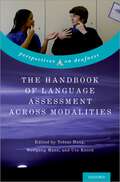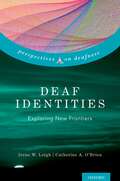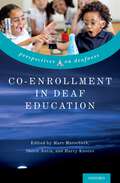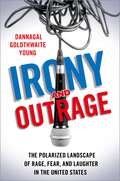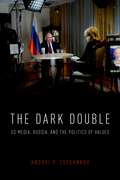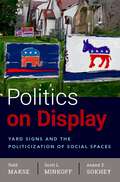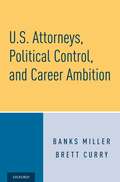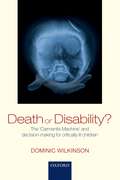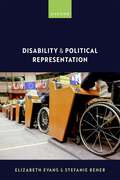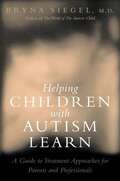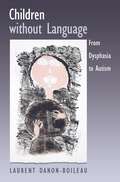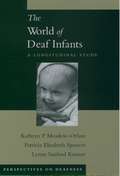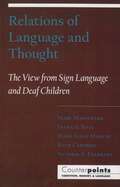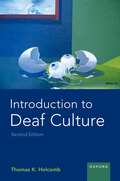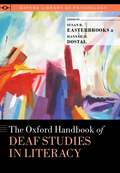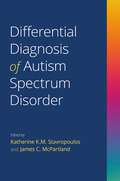- Table View
- List View
The Handbook of Language Assessment Across Modalities (Perspectives on Deafness)
by Tobias Haug, Wolfgang Mann and Ute KnochHistorically, research on spoken language testing dates back to the late 1920s with the majority of work starting around the time of World War II. In contrast, signed language assessment research is a young area, nested within signed language linguistics, deaf education, and applied linguistics. To this day, very few signed language tests that can be used in applied contexts are available for learners of a signed language. This volume addresses issues that are inherent to language assessment development, regardless of the modality of the language. Comprised of 36 chapters, the book takes a new approach to exploring theoretical and practical issues related to assessment of signed and spoken languages by bringing together well known experts from both fields to engage in stimulating discussions about key issues related to language assessment. Grouped around twelve topics, the volume editors present different perspectives to emphasize the points of similarity and chart a path for future interdisciplinary collaborations .
Deaf Identities: Exploring New Frontiers (Perspectives on Deafness)
Over the past decade, a significant body of work on the topic of deaf identities has emerged. In this volume, Leigh and O'Brien bring together scholars from a wide range of disciplines -- anthropology, counseling, education, literary criticism, practical religion, philosophy, psychology, sociology, and deaf studies -- to examine deaf identity paradigms. In this book, contributing authors describe their perspectives on what deaf identities represent, how these identities develop, and the ways in which societal influences shape these identities. Intersectionality, examination of medical, educational, and family systems, linguistic deprivation, the role of oppressive influences, the deaf body, and positive deaf identity development, are among the topics examined in the quest to better understand deaf identities. In reflection, contributors have intertwined both scholarly and personal perspectives to animate these academic debates. The result is a book that reinforces the multiple ways in which deaf identities manifest, empowering those whose identity formation is influenced by being deaf or hard of hearing.
Deaf Identities: Exploring New Frontiers (Perspectives on Deafness)
by Irene W. Leigh and Catherine A. O’BrienOver the past decade, a significant body of work on the topic of deaf identities has emerged. In this volume, Leigh and O'Brien bring together scholars from a wide range of disciplines -- anthropology, counseling, education, literary criticism, practical religion, philosophy, psychology, sociology, and deaf studies -- to examine deaf identity paradigms. In this book, contributing authors describe their perspectives on what deaf identities represent, how these identities develop, and the ways in which societal influences shape these identities. Intersectionality, examination of medical, educational, and family systems, linguistic deprivation, the role of oppressive influences, the deaf body, and positive deaf identity development, are among the topics examined in the quest to better understand deaf identities. In reflection, contributors have intertwined both scholarly and personal perspectives to animate these academic debates. The result is a book that reinforces the multiple ways in which deaf identities manifest, empowering those whose identity formation is influenced by being deaf or hard of hearing.
Co-Enrollment in Deaf Education (Perspectives on Deafness)
Co-enrollment programming in deaf education refers to classrooms in which a critical mass of deaf and hard-of-hearing (DHH) students is included in a classroom containing mainly hearing students and which is taught by both a mainstream teacher and a teacher of the deaf. It thus offers full access to both DHH and hearing students in the classroom through "co-teaching" and avoids academic segregation of DHH students, as well as their integration into classes with hearing students without appropriate support services or modification of instructional methods and materials. Co-enrollment thus seeks to give DHH learners the best of both (mainstream and separate) educational worlds. Described as a "bright light on the educational horizon," co-enrollment programming provides unique educational opportunities and educational access for DHH learners comparable to that of their hearing peers. Co-enrollment programming shows great promise. However, research concerning co-enrollment programming for DHH learners is still in its infancy. This volume sheds light on this potentially groundbreaking method of education, providing descriptions of 14 co-enrollment programs from around the world, explaining their origins, functioning, and available outcomes. Set in the larger context of what we know and what we don't know about educating DHH learners, the volume offers readers a vision of a brighter future in deaf education for DHH children, their parents, and their communities.
Co-Enrollment in Deaf Education (Perspectives on Deafness)
by Marc Marschark, Shirin Antia and Harry KnoorsCo-enrollment programming in deaf education refers to classrooms in which a critical mass of deaf and hard-of-hearing (DHH) students is included in a classroom containing mainly hearing students and which is taught by both a mainstream teacher and a teacher of the deaf. It thus offers full access to both DHH and hearing students in the classroom through "co-teaching" and avoids academic segregation of DHH students, as well as their integration into classes with hearing students without appropriate support services or modification of instructional methods and materials. Co-enrollment thus seeks to give DHH learners the best of both (mainstream and separate) educational worlds. Described as a "bright light on the educational horizon," co-enrollment programming provides unique educational opportunities and educational access for DHH learners comparable to that of their hearing peers. Co-enrollment programming shows great promise. However, research concerning co-enrollment programming for DHH learners is still in its infancy. This volume sheds light on this potentially groundbreaking method of education, providing descriptions of 14 co-enrollment programs from around the world, explaining their origins, functioning, and available outcomes. Set in the larger context of what we know and what we don't know about educating DHH learners, the volume offers readers a vision of a brighter future in deaf education for DHH children, their parents, and their communities.
Irony and Outrage: The Polarized Landscape of Rage, Fear, and Laughter in the United States
by Dannagal Goldthwaite YoungFor almost a decade, journalists and pundits have been asking why we don't see successful examples of political satire from conservatives or of opinion talk radio from liberals. This book turns that question on its head to argue that opinion talk is the political satire of the right and political satire is the opinion programming of the left. They look and feel like two different animals because their audiences are literally, two different animals. In Irony and Outrage, political and media psychologist Dannagal Goldthwaite Young explores the aesthetics, underlying logics, and histories of these two seemingly distinct genres, making the case that they should be thought of as the logical extensions of the psychology of the left and right, respectively. One genre is guided by ambiguity, play, deliberation, and openness, while the other is guided by certainty, vigilance, instinct, and boundaries. While the audiences for Sean Hannity and John Oliver come from opposing political ideologies, both are high in political interest, knowledge, and engagement, and both lack faith in many of our core democratic institutions. Young argues that the roles that these two genres play for their viewers are strikingly similar: galvanizing the opinion of the left or the right, mobilizing citizens around certain causes, and expressing a frustration with traditional news coverage while offering alternative sources of information and meaning. One key way in which they differ, however, concludes Young, is in their capacity to be exploited by special interests and political elites. Drawing on decades of research on political and media psychology and media effects, as well as historical accounts and interviews with comedians and comedy writers, Young unpacks satire's liberal "bias" and juxtaposes it with that of outrage's conservative "bias." She details how traits like tolerance for ambiguity and the motivation to engage with complex ideas shape our preferences for art, music, and literature; and how those same traits correlate with political ideology. In turn, she illustrates how these traits help explain why liberals and conservatives vary in the genres of political information they prefer to create and consume.
The Dark Double: US Media, Russia, and the Politics of Values
by Andrei P. TsygankovAlthough many observers argue that US-Russia relations are a simple reflection of elites' political and economic preferences in both countries, these preferences tend to arise from pre-existing belief systems that are deeply rooted in the public and accentuated by mass media. In Dark Double, Andrei P. Tsygankov focuses on the driving power of values and media, in addition to political and economic interests, in structuring US-Russia relations. By analyzing mainstream US newspapers and other media sources, Tsygankov identifies five media narratives involving Russia since the Cold War's end and studies them through a framework of three inter-related factors: historic and cultural differences between the two countries, inter-state competition, and polarizing domestic politics. He shows how Americans' negative views toward Russia draw from a deep wellspring of suspicion and are further enhanced by a biased media that regularly exploits such negativity, Russia's centralization of power and anti-American attitudes. Given the intensity of our current impasse with Russia, Dark Double represents an important intervention that forces us to think about the sources of conflict in a new way.
DARK DOUBLE C: US Media, Russia, and the Politics of Values
by Andrei P. TsygankovAlthough many observers argue that US-Russia relations are a simple reflection of elites' political and economic preferences in both countries, these preferences tend to arise from pre-existing belief systems that are deeply rooted in the public and accentuated by mass media. In Dark Double, Andrei P. Tsygankov focuses on the driving power of values and media, in addition to political and economic interests, in structuring US-Russia relations. By analyzing mainstream US newspapers and other media sources, Tsygankov identifies five media narratives involving Russia since the Cold War's end and studies them through a framework of three inter-related factors: historic and cultural differences between the two countries, inter-state competition, and polarizing domestic politics. He shows how Americans' negative views toward Russia draw from a deep wellspring of suspicion and are further enhanced by a biased media that regularly exploits such negativity, Russia's centralization of power and anti-American attitudes. Given the intensity of our current impasse with Russia, Dark Double represents an important intervention that forces us to think about the sources of conflict in a new way.
Politics on Display: Yard Signs and the Politicization of Social Spaces
by Todd Makse Scott Minkoff Anand SokheyPolitical yard signs are one of the most ubiquitous and conspicuous features of American political campaigns, yet they have received relatively little attention as a form of political communication or participation. In Politics on Display, Todd Makse, Scott L. Minkoff, and Anand E. Sokhey tackle this phenomenon to craft a larger argument about the politics of identity and space in contemporary America. Documenting political life in two suburban communities and a major metropolitan area, they use an unprecedented research design that leverages street-level observation of the placement of yard signs and neighborhood-specific survey research that delves into the attitudes, behavior, and social networks of residents. The authors then integrate these data into a geo-database that also includes demographic and election data. Supplemented by nationally-representative data sources, the book brings together insights from political communication, political psychology, and political geography. Against a backdrop of conflict and division, this book advances a new understanding of how citizens experience campaigns, why many still insist on airing their views in public, and what happens when social spaces become political spaces.
POLITICS ON DISPLAY C: Yard Signs and the Politicization of Social Spaces
by Todd Makse Scott Minkoff Anand SokheyPolitical yard signs are one of the most ubiquitous and conspicuous features of American political campaigns, yet they have received relatively little attention as a form of political communication or participation. In Politics on Display, Todd Makse, Scott L. Minkoff, and Anand E. Sokhey tackle this phenomenon to craft a larger argument about the politics of identity and space in contemporary America. Documenting political life in two suburban communities and a major metropolitan area, they use an unprecedented research design that leverages street-level observation of the placement of yard signs and neighborhood-specific survey research that delves into the attitudes, behavior, and social networks of residents. The authors then integrate these data into a geo-database that also includes demographic and election data. Supplemented by nationally-representative data sources, the book brings together insights from political communication, political psychology, and political geography. Against a backdrop of conflict and division, this book advances a new understanding of how citizens experience campaigns, why many still insist on airing their views in public, and what happens when social spaces become political spaces.
U.S. Attorneys, Political Control, and Career Ambition
by Banks Miller Brett CurryUnited States Attorneys (USAs), the chief federal prosecutors in each judicial district, are key in determining how the federal government uses coercive force against its citizens. How much control do national political actors exert over the prosecutorial decisions of USAs? This book investigates this question using a unique dataset of federal criminal prosecutions between 1986 and 2015 that captures both decisions by USAs to file cases as well as the sentences that result. Utilizing intuitions from principal-agent theory, work on the career ambition of bureaucrats and politicians, and selected case-studies, the authors develop and advance a set of hypotheses about control by the President and Congress. Harnessing variation across time, federal judicial districts, and five legal issue areas - immigration, narcotics, terrorism, weapons, and white-collar crime - Miller and Curry find that USAs are subject to considerable executive influence in their decision making, supporting findings about the increase of presidential power over the last three decades. In addition, they show that the ability of the President to appoint USAs to higher-level positions within the executive branch or to federal judgeships is an important mechanism of that control. This investigation sheds light on how the need to be responsive to popularly-elected principals channels the enormous prosecutorial discretion of USAs.
U.S. Attorneys, Political Control, and Career Ambition
by Banks Miller Brett CurryUnited States Attorneys (USAs), the chief federal prosecutors in each judicial district, are key in determining how the federal government uses coercive force against its citizens. How much control do national political actors exert over the prosecutorial decisions of USAs? This book investigates this question using a unique dataset of federal criminal prosecutions between 1986 and 2015 that captures both decisions by USAs to file cases as well as the sentences that result. Utilizing intuitions from principal-agent theory, work on the career ambition of bureaucrats and politicians, and selected case-studies, the authors develop and advance a set of hypotheses about control by the President and Congress. Harnessing variation across time, federal judicial districts, and five legal issue areas - immigration, narcotics, terrorism, weapons, and white-collar crime - Miller and Curry find that USAs are subject to considerable executive influence in their decision making, supporting findings about the increase of presidential power over the last three decades. In addition, they show that the ability of the President to appoint USAs to higher-level positions within the executive branch or to federal judgeships is an important mechanism of that control. This investigation sheds light on how the need to be responsive to popularly-elected principals channels the enormous prosecutorial discretion of USAs.
Death Or Disability?: The 'carmentis Machine' And Decision-making For Critically Ill Children
by Dominic WilkinsonIn ancient Rome parents would consult the priestess Carmentis shortly after birth to obtain prophecies of the future of their newborn infant. Today, parents and doctors of critically ill children consult a different oracle. Neuroimaging provides a vision of the child's future, particularly of the nature and severity of any disability. Based on the results of brain scans and other tests doctors and parents face heart-breaking decisions about whether or not to continue intensive treatment or to allow the child to die. Paediatrician and ethicist Dominic Wilkinson looks at the profound and contentious ethical issues facing those who work in intensive care caring for critically ill children and infants. When should infants or children be allowed to die? How accurate are predictions of future quality of life? How much say should parents have in these decisions? How should they deal with uncertainty about the future? He combines philosophy, medicine and science to shed light on current and future dilemmas.
Disability and Political Representation
by Prof Elizabeth Evans Dr Stefanie ReherDisability and Political Representation explores how disabled people experience the various stages and aspects of the representation process, drawing upon extensive empirical research and a variety of qualitative and quantitative data. It discusses why increasing the number of disabled politicians matters, not only as a matter of justice and equality but also to better represent the issues and interests of importance to disabled people. Evans and Reher identify a variety of ableist barriers prevent disabled people from fully participating in the political process, from disenfranchisement and inaccessible polling stations to prejudice within parties and a lack of financial support for candidates who require adjustments. The work shows that while the preferences of disabled citizens are currently under-represented in parliament, disabled representatives often draw on their lived experience to advocate for their interests. The concept of experiential representation is developed to help scholars and practitioners better navigate the concept of political representation, specifically as it relates to disability. Thus, the book explores how disability can help us think about the contours of political representation. It presents and analyses a range of diverse and original data, including qualitative data generated from interviews with disabled politicians and activists in the UK, quantitative survey data on the political attitudes and participation of disabled citizens from across Europe, and data from survey experiments examining voter perceptions of disabled politicians in the UK and the US.
Disability and Political Representation
by Prof Elizabeth Evans Dr Stefanie ReherDisability and Political Representation explores how disabled people experience the various stages and aspects of the representation process, drawing upon extensive empirical research and a variety of qualitative and quantitative data. It discusses why increasing the number of disabled politicians matters, not only as a matter of justice and equality but also to better represent the issues and interests of importance to disabled people. Evans and Reher identify a variety of ableist barriers prevent disabled people from fully participating in the political process, from disenfranchisement and inaccessible polling stations to prejudice within parties and a lack of financial support for candidates who require adjustments. The work shows that while the preferences of disabled citizens are currently under-represented in parliament, disabled representatives often draw on their lived experience to advocate for their interests. The concept of experiential representation is developed to help scholars and practitioners better navigate the concept of political representation, specifically as it relates to disability. Thus, the book explores how disability can help us think about the contours of political representation. It presents and analyses a range of diverse and original data, including qualitative data generated from interviews with disabled politicians and activists in the UK, quantitative survey data on the political attitudes and participation of disabled citizens from across Europe, and data from survey experiments examining voter perceptions of disabled politicians in the UK and the US.
Helping Children With Autism Learn: Treatment Approaches For Parents And Professionals
by Bryna SiegelBryna Siegel gives parents of autistic children what they need most: hope. Her first book, The World of the Autistic Child, became an instant classic, illuminating the inaccessible minds of afflicted children. Now she offers an equally insightful, thoroughly practical guide to treating thelearning disabilities associated with this heartbreaking disorder. The trouble with treating autism, Siegel writes, is that it is a spectrum disorder--a combination of a number of symptoms and causes. To one extent or another, it robs the child of social bonds, language, and intimacy--but the extent varies dramatically in each case. The key is to understandeach case of autism as a discrete set of learning disabilities, each of which must be treated individually. Siegel explains how to take an inventory of a child's particular disabilities, breaks down the various kinds unique to autism, discusses our current knowledge about each, and reviews theexisting strategies for treating them. There is no simple cure for this multifarious disorder, she writes; instead, an individual program, with a unique array of specific treatments, must be constructed for each child. She gives practical guidance for fashioning such a program, empowering parents totake the lead in their child's treatment. At the same time, she cautions against the proliferating, but questionable, treatments hawked to afflicted families. She knows the panic to do something, anything, to help an autistic child, and she offers parents reassurance and support as well as sensibleadvice, combining knowledge from experience, theory and research. For parents, autism in a child is heartbreaking. But it need not be overwhelming. Bryna Siegel offers a new understanding, and a practical, thoughtful approach, that will give parents new hope.
Children without Language: From Dysphasia to Autism
by Laurent Danon-BoileauCommunication and language disorders are often considered from one particular point of view - either psychological or neurological. Danon-Boileau argues that this is a serious mistake. He emphasizes that a child's trouble can stem from a variety of causes: neurological problems similar to those of aphasia, cognitive impairments, and psychological disorders, and, thus, the interaction of these elements needs to be taken into account. In precise case studies, Danon-Boileau describes the situations he has confronted and traces the causes of changes in the child when they happen. Combining linguistic, cognitive, and psycholanalytic approaches, Children without Language provides a unique perspective on speech and communication disorders in children and will be an essential volume for speech therapists, developmental psychologists, linguistics scholars and anyone wishing to reflect seriously on why we speak and how communication occurs.
The World of Deaf Infants: A Longitudinal Study (Perspectives on Deafness)
by Kathryn P. Meadow-Orlans Patricia Elizabeth Spencer Lynne Sanford KoesterWhat is the impact of an infant's diminished hearing on the infant and its parents? How does communication develop in cases of diminished hearing? How does diminished hearing affect social and cognitive development? What types of early interventions can improve communication and development in infants with diminished hearing? The World of Deaf Infants presents the results of a 15-year research study that addresses these questions. Through their research, perhaps the largest, long-term comparison of deaf and hearing infants, Meadow-Orlans's team provides a comprehensive and intimate look into the world of deaf infants. For a core group of 80 families that includs all four combinations of parent-infant hearing status, data was collected longitudinally at 9, 12, 15, and 18 months, and mother-infant interactions were recorded and observed in both structured and unstructured settings. Mothers' facial, vocal, and tactile behaviors during interactions were related to infants' temperament and stress; mothers' linguistic and communication behaviors, as well as their overall responsiveness, were related to children's language; and the effects of support provided to mothers were evaluated and explored. The results were dramatic, particularly those on infant attachment behaviors and the importance of visual attention to the overall development of deaf infants. This comprehensive work provides a foundation on which researchers, teachers, students, and parents can build to improve communication, cognitive and social development, and to enhance the world of deaf infants.
Relations Of Language And Thought: The View From Sign Language And Deaf Children
by Victoria S. Everhart Marc Marschark Patricia Siple Diane Lillo-Martin Ruth CampbellRelations of Language and Thought: The View from Sign Language and Deaf Children (Counterpoints: Cognition, Memory, and Language)
by Marc Marschark Patricia Siple Diane Lillo-Martin Ruth Campbell Victoria S. EverhartThe relationship of language to cognition, especially in development, is an issue that has occupied philosophers, psychologists, and linguists for centuries. In recent years, the scientific study of sign languages and deaf individuals has greatly enhanced our understanding of deafness, language, and cognition. This Counterpoints volume considers the extent to which the use of sign language might affect the course and character of cognitive development, and presents a variety of viewpoints in this debate. This volume brings the language-thought discussion into a clearer focus, both theoretically and practically, by placing it in the context of children growing up deaf and the influences of having sign language as their primary form of communication. The discussion is also sharpened by having internationally recognized contributors, such as Patricia Siple, Diane Lillo-Martin, and Ruth Campbell, with specialties in varied areas, all converging on a common interest in which each has conducted empirical research. These contributors clarify and challenge the theoretical assumptions that have driven arguments in the language-thought debate for centuries. An introduction by the editors provides a historical overview of the issues as well as a review of empirical findings that have been offered in response to questions about language-thought relations in deaf children. The final chapters are structured in the form of "live" debate, in which each contributor is given the opportunity to respond to the other perspectives presented in this volume.
Introduction to Deaf Culture (PROF PERSPECTIVES ON DEAFNESS SERIES)
by Thomas K. HolcombThomas K Holcomb's highly successful textbook on Deaf culture has been fully revised and updated in this second edition. The changes reflect those in the field and include three new chapters focusing on the impact of technology on the Deaf experience, the roles of allies in supporting the Deaf community, and the diversity that exists in the Deaf community. Also new to this edition is an ASL summary of each chapter, making the book accessible in two languages that are important in the Deaf community, ASL and English. The book provides a broad yet in-depth exploration of how Deaf people are best understood from a cultural perspective. It explores the tension between the Deaf and disabled communities, the cultural norms of the Deaf community, Deaf art and literature, the solutions being offered by the medical and Deaf communities for effective living as Deaf individuals, and an analysis of the universality of the Deaf experience. As a member of a multigenerational Deaf family with a lifetime of experience living bi-culturally among Deaf and hearing people, author Thomas K. Holcomb enhances the academic discussions with engaging stories and the poetry and art of Deaf individuals. In addition to being used in college-level courses, this book can also help parents and educators of Deaf children understand the world of Deaf culture. It offers a beautiful introduction to the ways Deaf people effectively manage their lives in a world full of people who hear.
Introduction to Deaf Culture (PROF PERSPECTIVES ON DEAFNESS SERIES)
by Thomas K. HolcombThomas K Holcomb's highly successful textbook on Deaf culture has been fully revised and updated in this second edition. The changes reflect those in the field and include three new chapters focusing on the impact of technology on the Deaf experience, the roles of allies in supporting the Deaf community, and the diversity that exists in the Deaf community. Also new to this edition is an ASL summary of each chapter, making the book accessible in two languages that are important in the Deaf community, ASL and English. The book provides a broad yet in-depth exploration of how Deaf people are best understood from a cultural perspective. It explores the tension between the Deaf and disabled communities, the cultural norms of the Deaf community, Deaf art and literature, the solutions being offered by the medical and Deaf communities for effective living as Deaf individuals, and an analysis of the universality of the Deaf experience. As a member of a multigenerational Deaf family with a lifetime of experience living bi-culturally among Deaf and hearing people, author Thomas K. Holcomb enhances the academic discussions with engaging stories and the poetry and art of Deaf individuals. In addition to being used in college-level courses, this book can also help parents and educators of Deaf children understand the world of Deaf culture. It offers a beautiful introduction to the ways Deaf people effectively manage their lives in a world full of people who hear.
The Oxford Handbook of Deaf Studies in Literacy (Oxford Library of Psychology)
The Oxford Handbook of Deaf Studies in Literacy brings together state-of-the-art research on literacy learning among deaf and hard of hearing learners (DHH). With contributions from experts in the field, this volume covers topics such as the importance of language and cognition, phonological or orthographic awareness, morphosyntactic and vocabulary understanding, reading comprehension and classroom engagement, written language, and learning among challenged populations. Avoiding sweeping generalizations about DHH readers that overlook varied experiences, this volume takes a nuanced approach, providing readers with the research to help DHH students gain competence in reading comprehension.
The Oxford Handbook of Deaf Studies in Literacy (Oxford Library of Psychology)
by Susan R. Easterbrooks Hannah M. DostalThe Oxford Handbook of Deaf Studies in Literacy brings together state-of-the-art research on literacy learning among deaf and hard of hearing learners (DHH). With contributions from experts in the field, this volume covers topics such as the importance of language and cognition, phonological or orthographic awareness, morphosyntactic and vocabulary understanding, reading comprehension and classroom engagement, written language, and learning among challenged populations. Avoiding sweeping generalizations about DHH readers that overlook varied experiences, this volume takes a nuanced approach, providing readers with the research to help DHH students gain competence in reading comprehension.
Differential Diagnosis of Autism Spectrum Disorder
Differential Diagnosis of Autism Spectrum Disorder provides a framework for clinical considerations and best practices related to diagnosing children with autism spectrum disorder (ASD) versus commonly co-occurring conditions. Differential diagnosis is a complex process, and it is common for clinicians to observe symptom overlap between conditions. In this comprehensive text, the authors focus on the similarities and differences between ASD and a second diagnosis. Leading experts provide practical guidance in the diagnostic process for ASD versus a second condition, such as anxiety or attention deficit/hyperactivity disorder. Each chapter includes clinical case studies to provide real-world examples of how clinicians make diagnostic decisions. Ample illustrations and 'decision trees' provide a visual representation of clinical decision-making.
